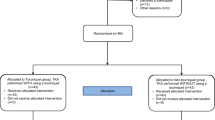Abstract
Introduction
Total knee arthroplasty is used to treat end-stage knee osteoarthritis with great results. Tourniquet use has become popular over the years because of its various benefits, but the literature regarding functional outcomes, pain and rehabilitation and comparison between tourniquet use and improvement cement penetration and overall improve fixation is limited. The authors proposed a hypothesis that cementation quality, and clinical outcomes can be influenced by tourniquet technique.
Methods
Fifty patients were allocated randomly in two groups: (1) tourniquet was inflated throughout all the procedure and (2) only during skin incision and cementation. Radiolucent lines were analyzed by two and independent examiners, using the The Knee Society Roentgenographic Evaluation and Scoring System. The functional scores used were the Oxford knee score and improvement in visual pain scale (VAS).
Results
After a mean follow-up period of 2.4 ± 0.2 years, no difference was observed regarding partial use of tourniquet in the cementation quality (p value > 0.05). There was no difference between groups regarding gender, age, knee side, Visual VAS, Oxford Score, total range-of-motion (ROM), knee extension and knee flexion (p value > 0.05).
Conclusions
No difference was attained regarding functional outcomes and cementation quality regarding two different tourniquet protocols.




Similar content being viewed by others
References
Pfitzner T, von Roth P, Ninja V, Mayr H, Perka C, Hube R (2016) Influence of the tourniquet on tibial cement mantle thickness in primary total knee arthroplasty. Knee Surg Sports Traumatol Arthrosc. 24(1):96–101
Touzopoulos P, Ververidis A, Mpogiatzis C, Chatzigiannakis A, Drosos GI (2019) The use of tourniquet may influence the cement mantle thickness under the tibial implant during total knee arthroplasty. Eur J Orthop Surg Traumatol 29(4):869–875
Bressi E, Longo UG, Mangiacapra F, Candela V, Berton A, Salvatore G et al (2019) Impact of tourniquet use on systemic inflammatory parameters, functional physical recovery, and cardiovascular outcomes of patients undergoing knee arthroplasty: a case-control study. J Knee Surg 33(8):762–767
Arthur JR, Spangehl MJ (2019) Tourniquet use in total knee arthroplasty. J Knee Surg 32(8):719–729
Barnsley L (2019) Detection of aseptic loosening in total knee replacements: a systematic review and meta-analysis. Skeletal Radiol 48(10):1565–1572
Flierl MA, Sobh AH, Culp BM, Baker EA, Sporer SM (2019) Evaluation of the painful total knee arthroplasty. J Am Acad Orthop Surg 27(20):743–751
Jawhar A, Stetzelberger V, Kollowa K, Obertacke U (2019) Tourniquet application does not affect the periprosthetic bone cement penetration in total knee arthroplasty. Knee Surg Sports Traumatol Arthrosc 7:2071–2081
Herndon CL, Grosso MJ, Sarpong NO, Shah RP, Geller JA, Cooper HJ (2020) Tibial cement mantle thickness is not affected by tourniquetless total knee arthroplasty when performed with tranexamic acid. Knee Surg Sports Traumatol Arthrosc 28(5):1526–1531
Wang D, Cao C, Li L, Meng W, Pei W, Li D, Zhou Z (2018) Tranexamic acid in primary total knee arthroplasty without tourniquet: a randomized, controlled trial of oral versus topical administration. Sci Rep 8:13579
Ewald FC (1989) The knee society total knee arthroplasty roentgenographic evaluation and scoring system. Clin Orthop Relat Res 248:9–12
Alexandersson M, Wang EY, Eriksson S (2019) A small difference in recovery between total knee arthroplasty with and without tourniquet use the first 3 months after surgery: a randomized controlled study. Knee Surg Sports Traumatol Arthrosc 27(4):1035–1042
Migliorini F, Maffulli N, Aretini P, Trivellas A, Tingart M et al. (2021) Impact of tourniquet during knee arthroplasty: a Bayesian network meta-analysis of peri-operative outcomes. Arch Orthop Trauma Surg (online ahead of print)
Tzatzairis T, Drosos GI, Vogiatzaki T, Tilkeridis K, Ververidis A, Kazakos K (2019) Multiple intravenous tranexamic acid doses in total knee arthroplasty without tourniquet: a randomized controlled study. Arch Orthop Trauma Surg 139(6):859–868
Alvarez J, Santiveri FJ, Ramos MI, Gallart L, Aguilera L, Puig-Verdie L (2019) Clinical trial on the effect of tranexamic acid on bleeding and fibrinolysis in primary hip and knee replacement. Rev Esp Anestesiol Reanim 6:299–306
Huang Z, Xie X, Li L, Huang Q, Ma J, Shen B (2017) Intravenous and topical tranexamic acid alone are superior to tourniquet use for primary total knee arthroplasty: a prospective, randomized controlled trial. J Bone Joint Surg Am 99(24):2053–2061
Dennis DA, Kittelson AJ, Yang CC, Miner TM, Kim RH, Stevens-Lapsley JE (2016) Does tourniquet use in TKA affect recovery of lower extremity strength and function? A randomized trial. Clin Orthop Relat Res 474(1):69–77
Ozkunt O, Sariyilmaz K, Gemalmaz HC, Dikici F (2018) The effect of tourniquet usage on cement penetration in total knee arthroplasty: a prospective randomized study of 3 methods. Medicine 97(4):e9668
Harsten A, Bandholm T, Kehlet H, Toksvig-Larsen S (2015) Tourniquet versus no tourniquet on knee-extension strength early after fast-track total knee arthroplasty; a randomized controlled trial. Knee 22(2):126–130
Funding
The authors do not receive any financial support of third parties to conceive this manuscript.
Author information
Authors and Affiliations
Contributions
MAPA and GMA-S conceived the idea for the study; GMA-S designed the study. LFRM, TRD collected the relevant data (clinical and radiographic data). PL performed the statistical analyses. GMA-S and MAPA interpreted the data and contributed to preparation of the manuscript.
Corresponding author
Ethics declarations
Conflict of interest
The authors of the paper entitled have no conflict of interest regarding the conception and production of this article.
Additional information
Publisher's Note
Springer Nature remains neutral with regard to jurisdictional claims in published maps and institutional affiliations.
Rights and permissions
About this article
Cite this article
Andrade, M.A.P., Monte, L.F.R., Lacerda, G.C. et al. Are cementation quality and clinical outcomes affected by the use of tourniquet in primary total knee arthroplasty?. Arch Orthop Trauma Surg 142, 845–850 (2022). https://doi.org/10.1007/s00402-021-03865-5
Received:
Accepted:
Published:
Issue Date:
DOI: https://doi.org/10.1007/s00402-021-03865-5




